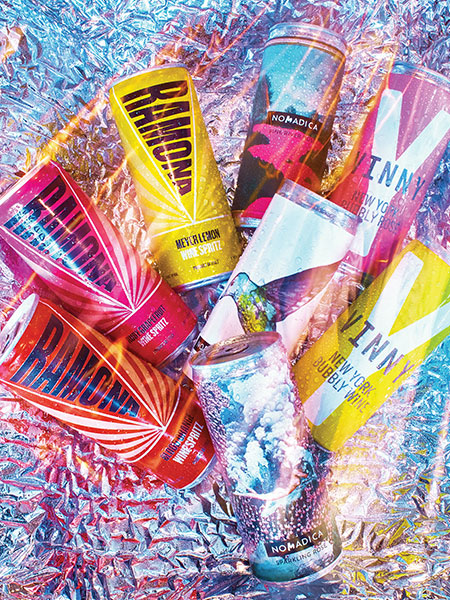In a 2009 episode of It’s Always Sunny in Philadelphia, the gang discovered canned wine. The characters, who drank a lot on the show, appreciated how the cans rendered their violent, aggressive gesturing spill-free. In those days, they were canning it themselves, filling empty sodas from a box of wine. There are better options today, with serious winemakers opting for cans. In fact, the format offers a wide range of benefits for consumers and producers alike: lower shipping weights, easily recyclable containers and portability—no need for corkscrews or glasses—to name a few. This year, more winemakers will be focusing their energy on shipping sustainable and delicious wines in cans, and they may have received a jump start from an unexpected source.


The explosion of the hard seltzer market last summer (a 200 percent increase to $55 million) has opened consumers’ minds to canned drinks that aren’t beer. Summer drinkers are thirsty for something portable, light and sessionable—bonus points if it tastes good. Jordan Salcito expects to see Ramona, her label of canned wine spritzes, buoyed by the rising tide of hard seltzer. The hard-seltzer boom is “the gateway to non-beer cans,” as Salcito put it. Sometimes, that transition is direct. Salcito recalls how Steven McDonald of Pappas Bros. introduced a group of diners asking for White Claw to Ramona with great success.
While they’re not health beverages by any metric, hard seltzer and canned wine spritzes mesh well with the idea of “wellness as a spectrum.” Rather than cut out alcohol entirely, people might choose options that are lower in alcohol (and therefore lower in calories). Practically speaking, the ease of cracking open a can—at the beach, at the summit of your Saturday morning hike, after a day of bouldering or at the end of your charity 10K—helps to fit wine into more active lifestyles. Increasingly, producers are looking to cans for their lower-alcohol offerings, too. Salcito plans to launch a drier, five-percent-alcohol version of the Ramona grapefruit spritz in May. Alexandre Remy of Oro Bello has begun canning what he calls “Oro Bello Light,” California chardonnay under 10 percent alcohol; he prominently advertises the nutritional info—calories, carbohydrates, fat, protein and alcohol—on the outside of the can. Only 85 calories per serving…but 2.5 servings per can.
Meanwhile, the alcohol levels of hard seltzer continue to evaporate with the release of “White Claw 70,” a 70-calorie can at 3.7 percent abv. Are they closing in on a non-alcoholic hard seltzers, as in, reverting to the ubiquitous Perrier of the nineties?
If you want something more substantial from your session-ready can, you might start with the Ramona Ruby Grapefruit. Ramona’s original spritz speaks of summer from start to finish, and the grapefruit bitterness provides a pleasant counterpoint to the pink citrus and floral notes that keep it fresh. Thomas Pastuszak’s Vinny delivers a tart, bright sparkling wine from a can, hiding a dried apricot intensity underneath the green apple bite. Or check out Nomadica’s North Coast releases selected by Kristin Olszewski and Emma Toshack. They’re canning still and sparkling wines, offering a balance of succulent, juicy fruit and zingy acidity across a range of releases. Their Dry River Rosé combines crystalline red fruit, a base of brandied cherry spice and brown sugar darkness—somehow light and refreshing enough to want to reach for another immediately after finishing the first.
Corey Warren is the Tastings Editor in addition to covering the wines of the Loire, Southern France, Argentina and South Africa.
This story appears in the print issue of August 2020.
Like what you read? Subscribe today.
















